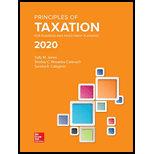
a.
Calculate
a.
Explanation of Solution
Opportunity 1:
Step 1: Calculate present value.
| Year 0 | Year 1 | Year 2 | |
| Before-tax | $(8,000) | $5,000 | $20,000 |
| Less: Tax cost | $(3,200) | $(2,000) | $(8,000) |
| After-tax cash flow | $4,800 | $3,000 | $12,000 |
| Multiply: Discount factor at 5% | - | ||
| Present value | $(4,800) | $2,856 | $10,884 |
Working note:
Calculate tax cost.
| Year 0 | Year 1 | Year 2 | |
| Taxable income | $8,000 | $5,000 | $20,000 |
| Multiply: Marginal tax rate | |||
| Tax cost | $3,200 | $2,000 | $8,000 |
Step 2: Calculate NPV.
Opportunity 2:
Step 1: Calculate present value.
| Year 0 | Year 1 | Year 2 | |
| Before-tax cash flow | $6,000 | $5,000 | $5,000 |
| Less: Tax cost | $(2,400) | $(2,000) | $(2,000) |
| After-tax cash flow | $3,600 | $3,000 | $3,000 |
| Multiply: Discount factor at 5% | - | ||
| Present value | $3,600 | $2,856 | $2,721 |
Working note:
Calculate tax cost.
| Year 0 | Year 1 | Year 2 | |
| Taxable income | $6,000 | $5,000 | $5,000 |
| Multiply: Marginal tax rate | |||
| Tax cost | $2,400 | $2,000 | $2,000 |
Step 2: Calculate NPV.
The value of net present value (NPV) of Opportunity 2 is greater than Opportunity 1. Hence, Firm E should choose Opportunity 2.
b.
Calculate net present value (NPV) and identify the opportunity that Firm E should choose.
b.
Explanation of Solution
Opportunity 1:
Step 1: Calculate present value.
| Year 0 | Year 1 | Year 2 | |
| Before-tax cash flow | $(8,000) | $5,000 | $20,000 |
| Less: Tax cost | $(1,200) | $(750) | $(3,000) |
| After-tax cash flow | $6,800 | $4,250 | $17,000 |
| Multiply: Discount factor at 5% | - | ||
| Present value | $(6,800) | $4,046 | $15,419 |
Working note:
Calculate tax cost.
| Year 0 | Year 1 | Year 2 | |
| Taxable income | $8,000 | $5,000 | $20,000 |
| Multiply: Marginal tax rate | |||
| Tax cost | $1,200 | $750 | $3,000 |
Step 2: Calculate NPV.
Opportunity 2:
Step 1: Calculate present value.
| Year 0 | Year 1 | Year 2 | |
| Before-tax cash flow | $6,000 | $5,000 | $5,000 |
| Less: Tax cost | $(900) | $(750) | $(750) |
| After-tax cash flow | $5,100 | $4,250 | $4,250 |
| Multiply: Discount factor at 5% | - | ||
| Present value | $5,100 | $4,046 | $3,855 |
Working note:
Calculate tax cost.
| Year 0 | Year 1 | Year 2 | |
| Taxable income | $6,000 | $5,000 | $5,000 |
| Multiply: Marginal tax rate | |||
| Tax cost | $900 | $750 | $750 |
Step 2: Calculate NPV.
The value of net present value (NPV) of Opportunity 2 is greater than Opportunity 1. Hence, Firm E should choose Opportunity 2.
c.
Calculate net present value (NPV) and identify the opportunity that Firm E should choose.
c.
Explanation of Solution
Opportunity 1:
Step 1: Calculate present value.
| Year 0 | Year 1 | Year 2 | |
| Before-tax cash flow | $(8,000) | $5,000 | $20,000 |
| Less: Tax cost | $(3,200) | $(750) | $(3,000) |
| After-tax cash flow | $4,800 | $4,250 | $17,000 |
| Multiply: Discount factor at 5% | - | ||
| Present value | $(4,800) | $4,046 | $15,419 |
Working note:
Calculate tax cost.
| Year 0 | Year 1 | Year 2 | |
| Taxable income | $8,000 | $5,000 | $20,000 |
| Multiply: Marginal tax rate | |||
| Tax cost | $3,200 | $750 | $3,000 |
Step 2: Calculate NPV.
Opportunity 2:
Step 1: Calculate present value.
| Year 0 | Year 1 | Year 2 | |
| Before-tax cash flow | $6,000 | $5,000 | $5,000 |
| Less: Tax cost | $(2,400) | $(750) | $(750) |
| After-tax cash flow | $3,600 | $4,250 | $4,250 |
| Multiply: Discount factor at 5% | - | ||
| Present value | $3,600 | $4,046 | $3,855 |
Working note:
Calculate tax cost.
| Year 0 | Year 1 | Year 2 | |
| Taxable income | $6,000 | $5,000 | $5,000 |
| Multiply: Marginal tax rate | |||
| Tax cost | $2,400 | $750 | $750 |
Step 2: Calculate NPV.
The value of net present value (NPV) of Opportunity 1 is greater than Opportunity 2. Hence, Firm E should choose Opportunity 1.
Want to see more full solutions like this?
Chapter 3 Solutions
PRINCIPLES OF TAXATION F/BUS...(LL)
 Intermediate Financial Management (MindTap Course...FinanceISBN:9781337395083Author:Eugene F. Brigham, Phillip R. DavesPublisher:Cengage LearningPrinciples of Accounting Volume 2AccountingISBN:9781947172609Author:OpenStaxPublisher:OpenStax College
Intermediate Financial Management (MindTap Course...FinanceISBN:9781337395083Author:Eugene F. Brigham, Phillip R. DavesPublisher:Cengage LearningPrinciples of Accounting Volume 2AccountingISBN:9781947172609Author:OpenStaxPublisher:OpenStax College



